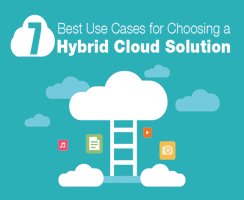
Of all the greatest feats Information Technology has seen so far, none can surpass the astonishing accomplishments of cloud computing technology and the way it has altered the entire course of data storage and management. And now with the cloud, businesses and enterprises are provided with computing services like servers, databases, analytics, servers and much more.
Since the Public Cloud is managed by the third-party service provider, if there occurs an event of an error or blackout, the entire organization is left paralyzed and unable to access the data and the applications. And while with Private Cloud an organization can customize the infrastructure and the setup according to their needs, it is a hefty task and almost improbable to manage the whole datacenter without any technical issues.
So why Hybrid Cloud? How does it transform a business enterprise? How can an organized enterprise benefit by having a Hybrid Cloud infrastructure model? That’s all the questions we are going to explore.
Scalability
When it comes to the growing enterprises, scaling on-premises infrastructure is, in fact, expensive and in order to make it cost-effective, it demands extremely accurate growth predictions. So with Hybrid Cloud, enterprises can have access to limitless resources on-demand. It is important to note that according to a report by International Data Group (IDG), 24% of large companies have reduced their operational costs as a direct result of hybrid cloud and its sheer prowess of on-demand scalability.
Moreover, we can align our entire architecture so as to utilize the performance requirement that was being done only by dedicated servers. So an enterprise can navigate through the workloads by adequate scalable network systems.
Highly secure
It may pose a major threat to the entire organization if the data and classified information are at the risk of being exposed to unauthorized users. Since hybrid cloud is neither entirely public, hence putting the resources on the hands of third-party vendors like Amazon Web services or Azure, nor exclusively private in order to restrict the timely support of external data centers, an enterprise can have dedicated servers and network devices that can restrict the access, thus minimizing the possible security breach.
Pay for what you use
Although cloud computing is for everyone, it may not have to be for everything. Why should we have to pay the bill for computing services that we no longer need? Yes, it is a fact that some of the workloads in an enterprise can only be tackled by trusted hardware systems. But an organization has to be flexible enough to enhance the speed to market and be prepared for the fluctuating traffic. So with hybrid cloud, we can own the base configuration and rent the sharp increase, so the company may pay for only the services they use.
Disaster management
Can we imagine the scenario where we are completely unarmed when disaster strikes and our data was threatened to be lost, forever? The backup sites and applications used to inoculate the data from external forces can easily be availed in the hybrid cloud. It is a fact that on-premises datacenters are instituted just to prevent these instances of data loss, but with hybrid cloud, an enterprise can have a flexible and cost-saving environment.
Since the hybrid cloud is easily afforded and set up, the recovery model provided by it is highly trustworthy and data recovery is done in a short span of time.
Cloud bursting
Simply put, cloud bursting is a configuration setting that helps the enterprises to deal with the workloads during the unprecedented surge in IT demands. For instance, if an organization with Private Cloud infrastructure overflows with its resource capacity, the surfeit amount of workload is directed to the immediately available cloud.
But since hybrid cloud employs both public and private clouds to handle the tasks, however large, an enterprise can easily manage the tasks even when we have to deal with a heap of massively demanding works.
Freedom in data management
There may be some highly classified data or information we may hesitate to share with the third-party service providers since it may require a company to risk privacy and security. But it is inevitable that the growing collectives of data and applications demand and forces an enterprise to share the data center since the workload is sometimes so massive for a private cloud to contain.
So the hybrid cloud facilitates the enterprises to have the utmost control over the data that are delicate and therefore should be privatized. For example, if a banking sector would like to operate on a hybrid cloud environment, hypersensitive data like the private bank statements of the account holders or the key information regarding the nature of the account can be reduced to the constrained of the bank itself. But at the same time, less-sensitive data that holds no real threat to the account holder or the bank can be stored on the public cloud.
Best performance
It is indubitably the sole goal of an enterprise or an organization would be to increase the productivity that never sacrifices the quality of the product or an application. At the same time, that particular product should reach and be deployed in the market in a short span of time. These fundamental aspects are met with hybrid cloud with much lucidity and fecundity.
Hybrid cloud takes into account the advantages it could gain from both public cloud and private cloud. When the strengths of these two clouds are fused together to form the powerful environment where tons of workloads are lofted with much easiness, an enterprise could be elevated to the glorified phase where its strengths are revealed to be insurmountable.

